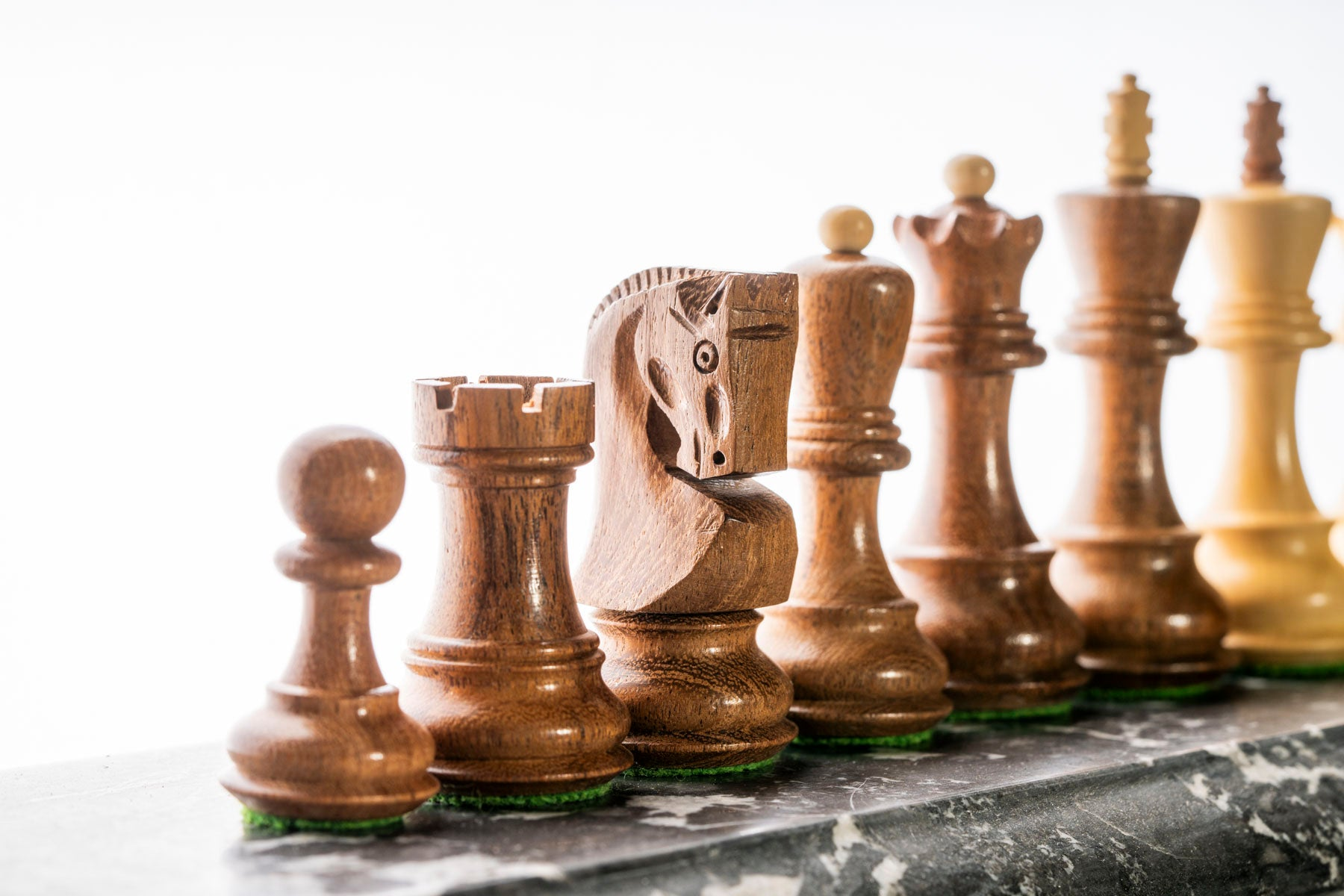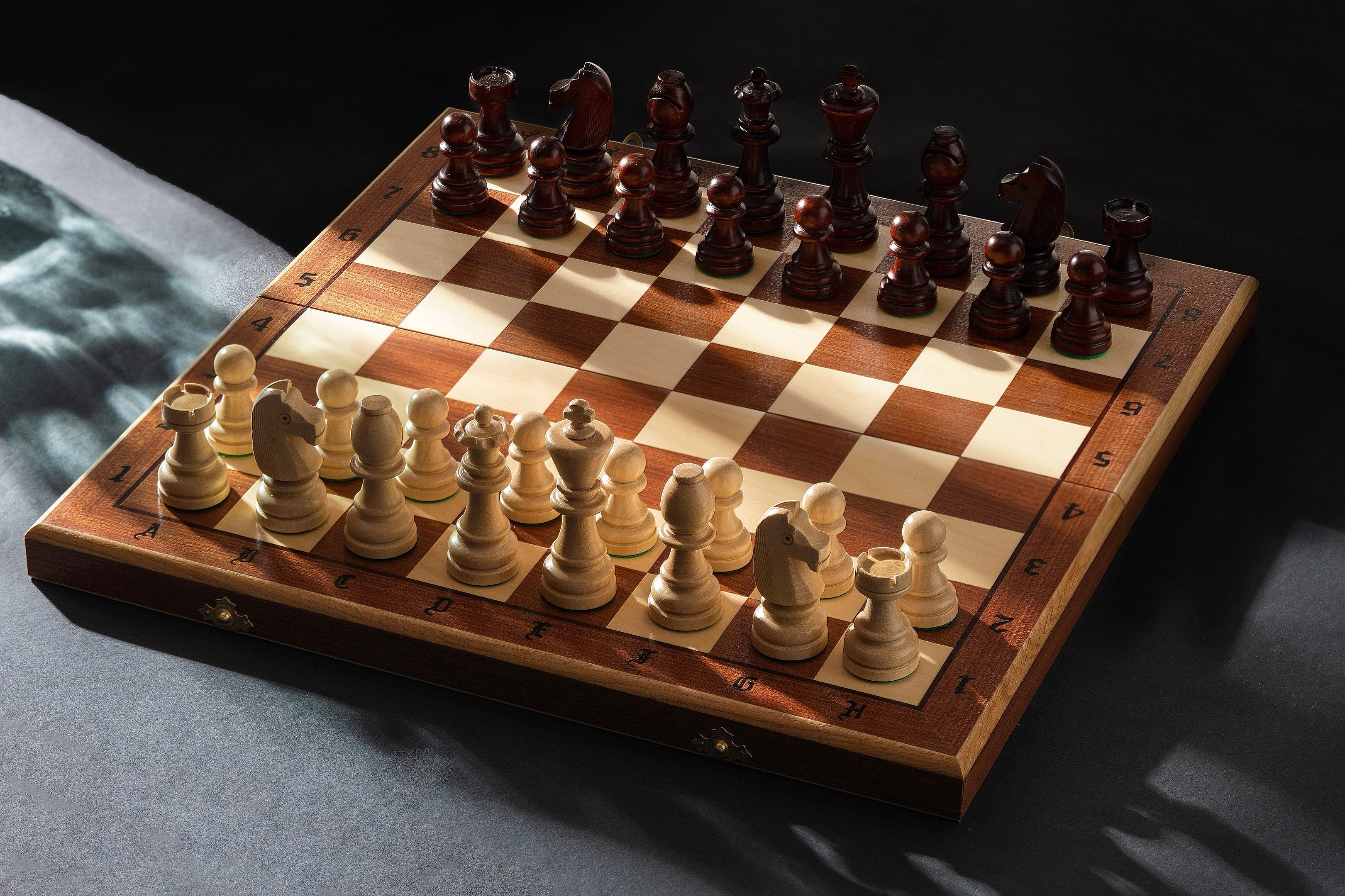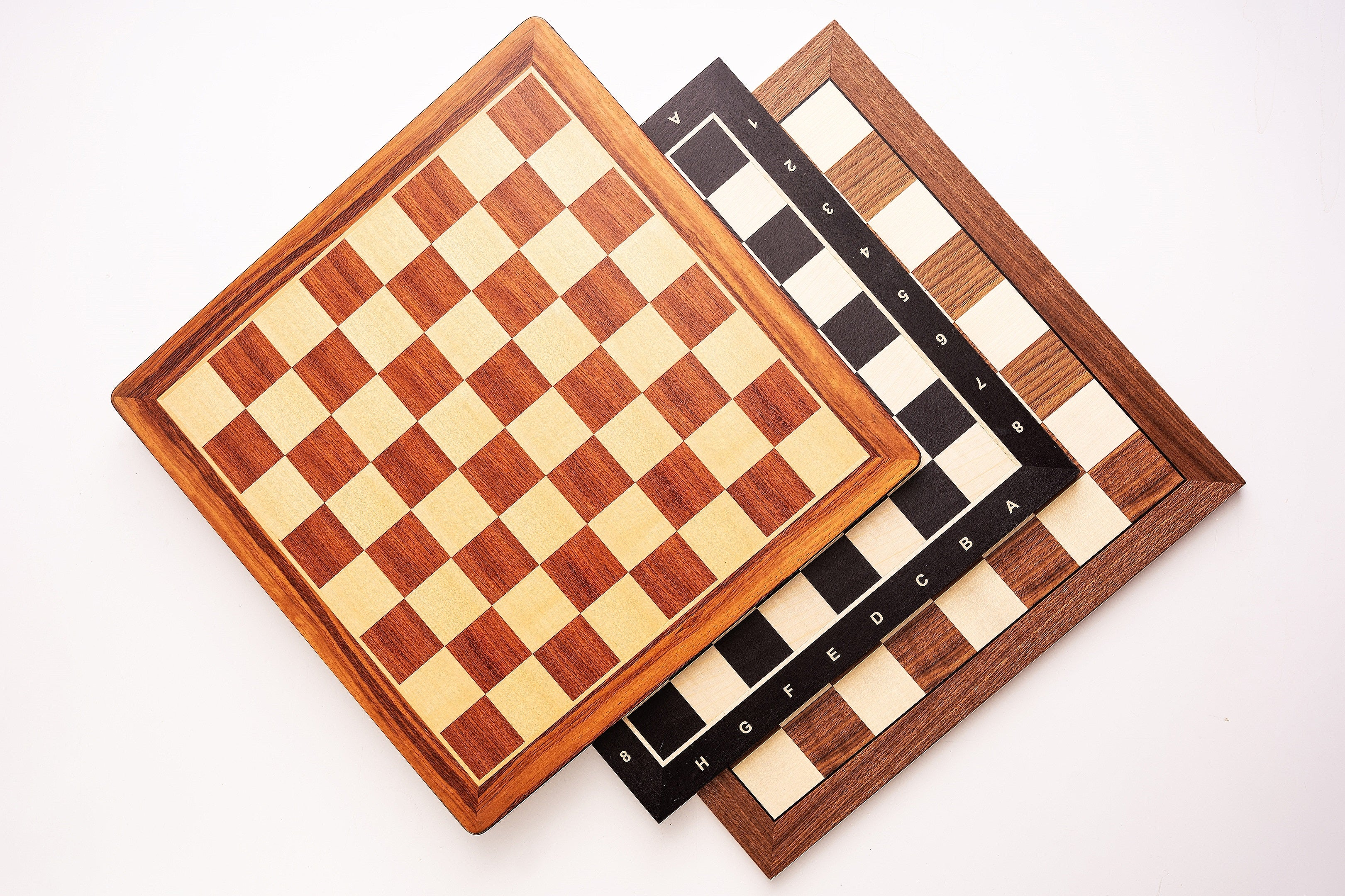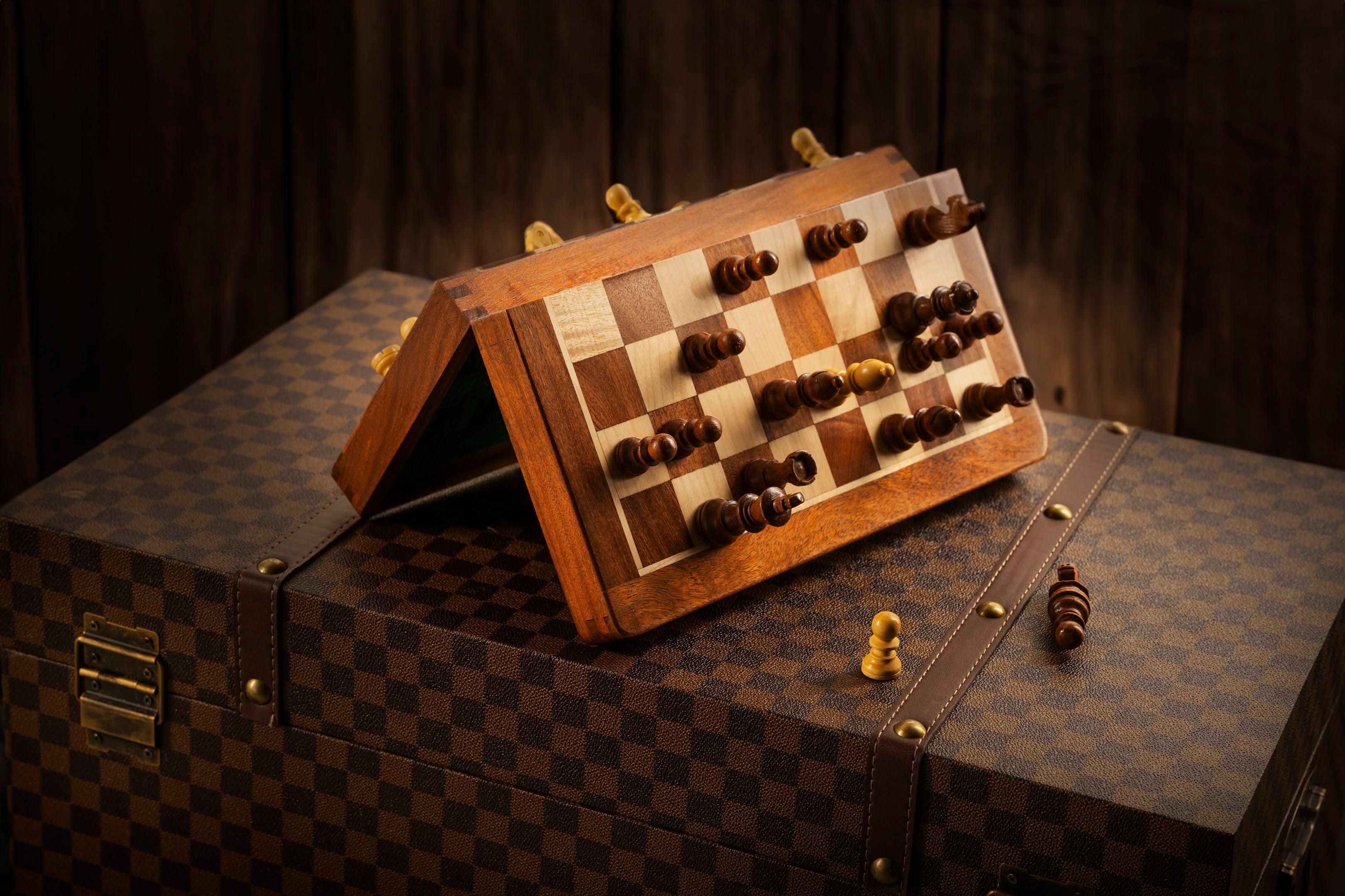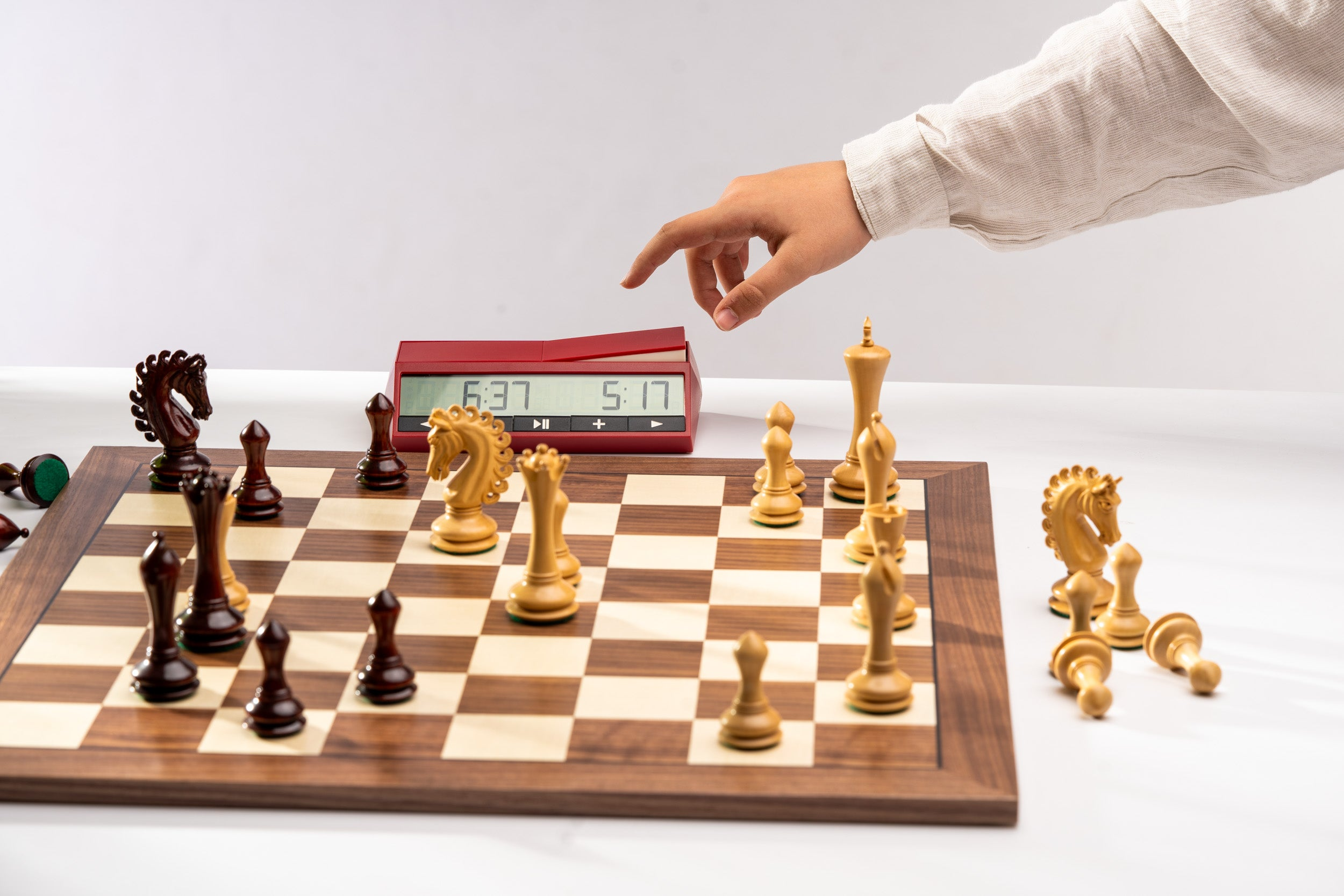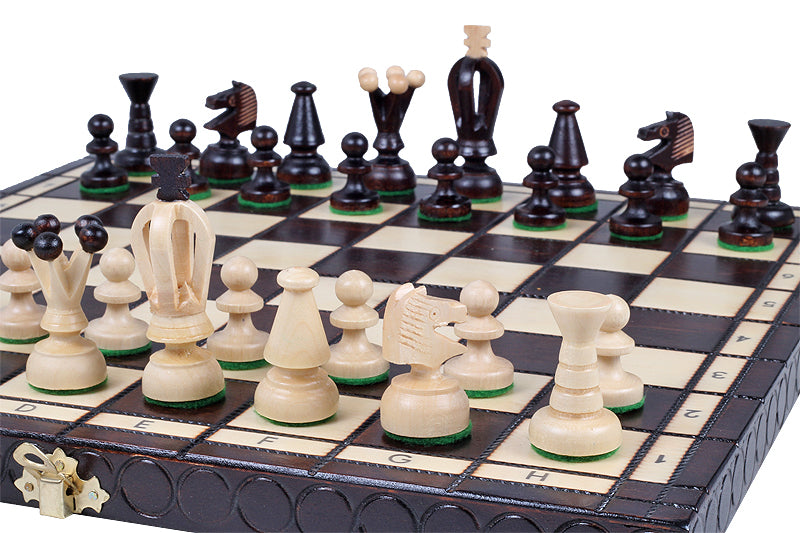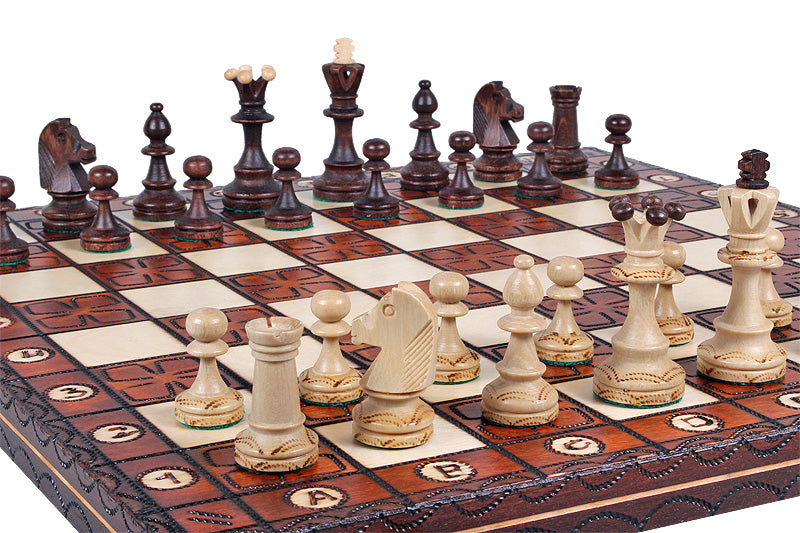
Handmade Quality
Crafted by skilled artisans using traditional techniques.

2–4 Days Delivery
UPS tracked shipping for fast and safe delivery.

FIDE Approved
Official standards for tournaments and clubs.

Secure Checkout
Payments protected via Stripe, PayPal and SSL.

Player Designed
Made by real chess players for performance and feel.

Top Support
Real human help, no bots, 7 days a week.
Chess Categories
Chess Pieces
Chess Sets
Chess Boards
Magnetic Chess Sets
Chess Clocks
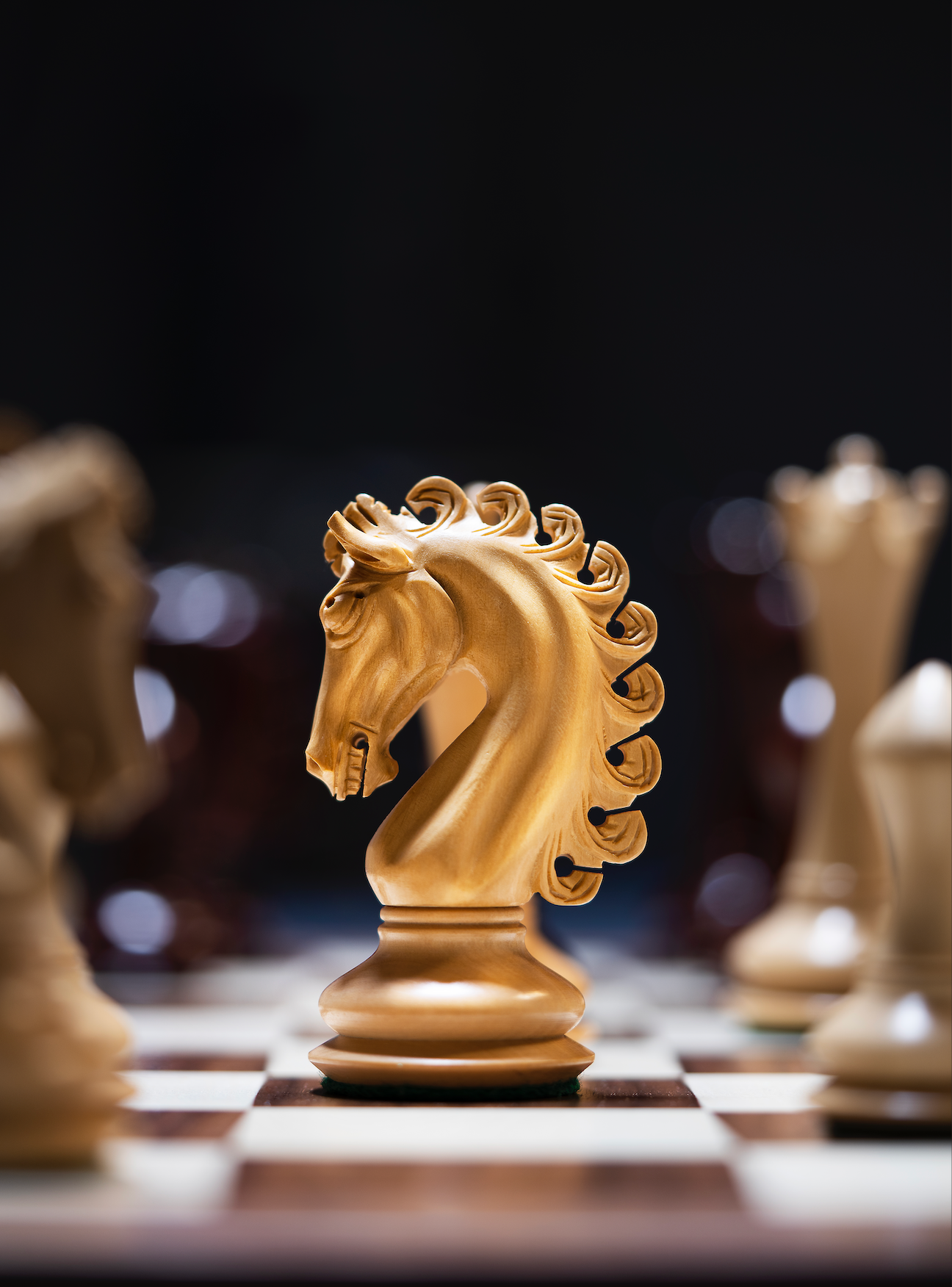
Chess Pieces
Made with care and unconditionally loved by our customers, this signature bestseller exceeds all expectations.
Chess Storage Boxes & Bags
Discover our range of storage solutions designed to keep your chess pieces, boards, and clocks safe and organized.
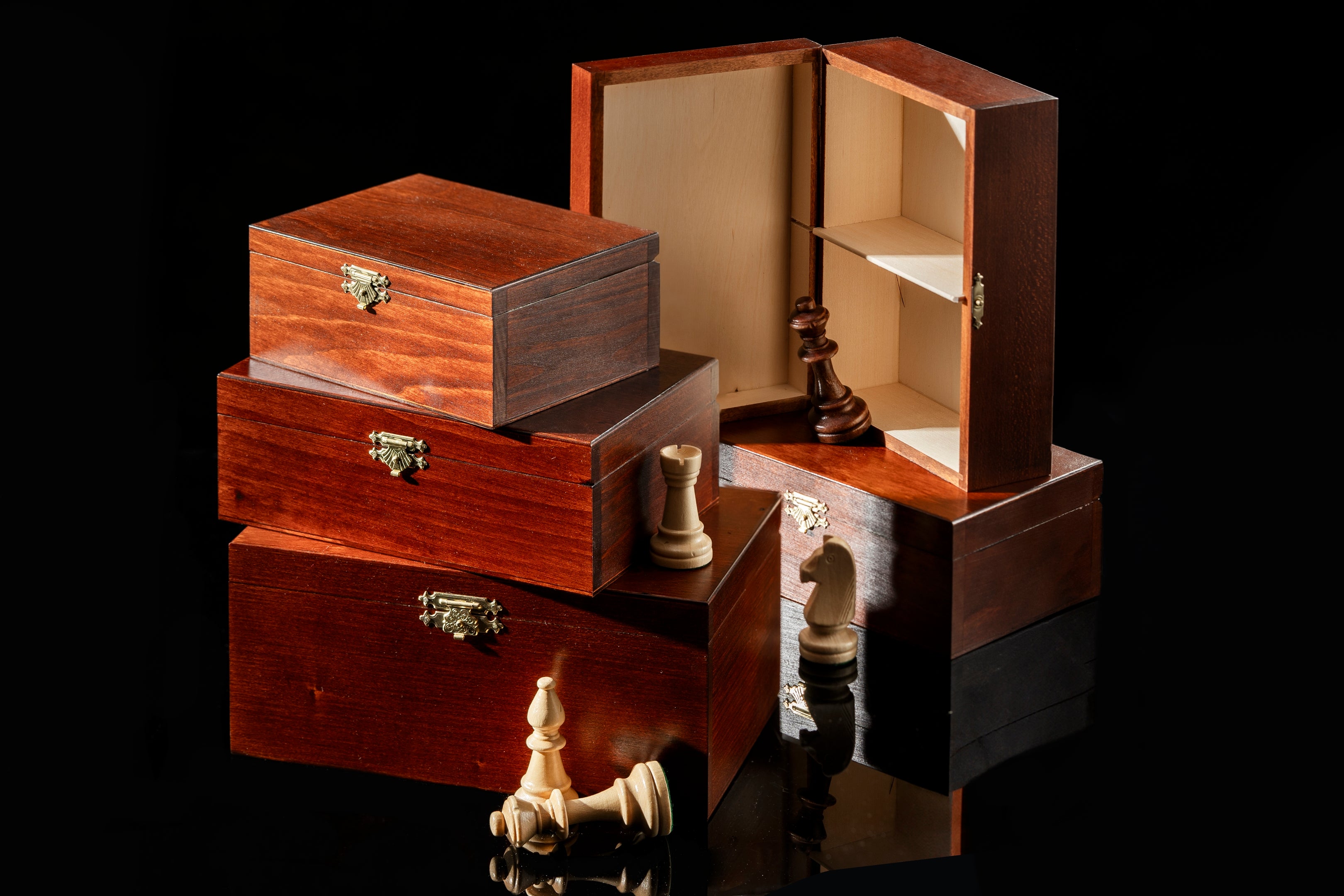
Looking for a dependable place to buy chess boards, pieces and accessories in Britain? Welcome to Chess-Set.co.uk, a specialist store stocking everything from pocket-size magnetic sets to FIDE-approved tournament gear. All items are warehoused in the UK for quick dispatch
Chess Boards: Materials, Sizes & Price Guide
Common Woods & Finishes
- Walnut & Maple – rich chocolate grains paired with pale sapwood for classic contrast.
- Mahogany & Sycamore – warm reddish tones with tight, uniform lines.
- Wenge & Birch – near-black squares against creamy white for contemporary interiors.
- Padauk – striking orange-red that deepens with age; often veneered to keep weights sensible.
- Ebony (Ebonised Boxwood) – jet-black elegance without the CITES paperwork.
- Rosewood & Sheesham – reddish-brown swirls beloved by collectors.
- Olive or Walnut Burl – dramatic marbling on luxury display boards.
Typical Chess-Board Price Range:
-
Entry-level vinyl roll-ups
– £7 – £20 -
Veneered hardwood boards (15″ – 18″)
– £70 – £120 -
Solid luxury boards (21″ – 23″)
– £200 – £400 -
Hand-inlaid exhibition boards (24″ +)
– £450 – £800 +
Board-to-Piece Size Guide
| Intended Use | Square Size (mm) | Square Size (in) | Recommended King Height* | Ideal King Base Ø (≈ 75 % – 80 % of square) |
|---|---|---|---|---|
| FIDE tournament / club events | 55 mm | 2.16″ | 95 – 102 mm (3.75 – 4.0″) | 41 – 44 mm (1.6 – 1.75″) |
| Club / home display | 50 mm | 1.97″ | 90 – 96 mm (3.5 – 3.8″) | 38 – 40 mm (1.5 – 1.6″) |
| Compact home / analysis | 45 mm | 1.77″ | 80 – 88 mm (3.2 – 3.5″) | 34 – 36 mm (1.35 – 1.45″) |
| Coffee-table / travel analysis | 40 mm | 1.57″ | 70 – 76 mm (2.8 – 3.0″) | 30 – 32 mm (1.2 – 1.25″) |
| Pocket / fold-up travel | 30 – 35 mm | 1.18 – 1.38″ | 55 – 65 mm (2.2 – 2.6″) | 23 – 26 mm (0.9 – 1.0″) |
Chess Pieces: Names, Roles & Sizing
How Many Pieces in a Set?
A standard set contains 32 pieces—16 per side
-
King × 1 — one square in any direction
-
Queen × 1 — any number of squares, any direction
-
Rooks × 2 — straight lines horizontally or vertically
-
Bishops × 2 — diagonals only
-
Knights × 2 — “L-shape” (two squares one way, then one square perpendicular)
-
Pawns × 8 — forward 1 (or 2 on first move); capture one square diagonally
Piece Size Guide
| King Height (in) | King Height (mm) | Ideal Square Size (mm) | Typical Use |
|---|---|---|---|
| 3.0 – 3.5″ | 76 – 89 mm | 45 mm | Compact play, coffee-table sets |
| 3.75 – 4.0″ | 95 – 102 mm | 55 mm | FIDE & USCF tournament standard |
| 4.25 – 4.5″ | 108 – 114 mm | 60 mm | Display or exhibition boards |
Complete Chess Sets
What Exactly Is a Staunton Chess Set?
-
Origin & Date – Introduced to the public on 29 September 1849 by the games-maker John Jaques of London. The design itself was registered earlier that year.
-
Designer vs. Namesake – Patent credited to illustrator Nathaniel Cooke, but the set was branded with the name of England’s top player of the era, Howard Staunton, who formally endorsed it.
-
Immediate Impact – Its clean, easily recognisable silhouettes supplanted ornate “St George” and “Regence” styles, quickly becoming the preferred pieces for serious play throughout Europe and America
-
Key Visual Features
-
Broad, felted bases for stability
-
Knight sculpted as a realistic stallion’s head
-
Bishop with a deep mitre slot
-
Distinct coronet-crowned queen and cross-topped king
-
-
Practical Advantages – Standardised heights and weights make the pieces comfortable to handle, easy to manufacture, and simple to identify at a glance—critical for fast or competitive time controls.
-
Modern Status – The Staunton pattern (or close derivatives) is mandatory for FIDE-rated events and remains the reference design for virtually all tournament equipment worldwide.
Hand-Made in Poland
Every wooden set at Chess-Set.co.uk is carved in Poland by master craftsmen using responsibly sourced, FSC-certified hardwoods—walnut, maple, sycamore and other premium timbers chosen for strength and beauty. Each knight is hand-finished to give your board a unique, crisp character you can feel the moment you lift a piece.
How Much Does a Chess Set Cost?
-
Plastic club kit with roll-up vinyl board
– £15 – £30 -
Mid-range wooden Staunton set on veneered board
– £120 – £250 -
Luxury triple-weighted ebony set with walnut board & storage box
– £500 – £900 (varies with wood rarity and hand-carving labour)
What Is “Rule 35” in Chess Equipment?
-
What it means – For a 45 mm square, the king’s base diameter should be no greater than 35 mm.
-
Origin – A collector’s shortcut built from the official FIDE guideline that a king’s base be roughly 75 – 80 % of the square width (and 40 – 50 % of its own height).
-
Why it matters – Keeping bases under the “35 mm on 45 mm” threshold prevents pieces from crowding files and ranks, reducing accidental knock-overs in fast play.
-
How to use it – Apply the same 75–80 % rule to any board size:
-
50 mm squares → king base ≈ 37–40 mm
-
55 mm squares (tournament) → king base ≈ 41–44 mm
-
60 mm squares → king base ≈ 45–48 mm
-
Magnetic, Electronic & Themed Equipment
Magnetic Travel Sets – Play Anywhere, Zero Slip
-
Fold-up briefcase design (7–12″ closed): board halves latch shut, with a felt-lined cavity to store every piece.
-
Rare-earth magnets in both base and square give a firm “click” that survives train jolts, café bumps, even light turbulence on flights.
-
Weight & balance: kings average 18–25 g, heavy enough for blitz yet light enough for backpacks.
-
Materials: injection-moulded ABS for budget kits; sheesham-and-boxwood or maple-and-walnut veneers for premium miniatures.
-
Ideal users: commuters, students, holidaymakers, coaches running demo boards.
-
Typical UK pricing (2025): £18–£30 for plastic 10″ kits, £60–£90 for hand-carved 12″ wood sets with algebraic notation.
Electronic Smart Boards – Stream, Train & Analyse
-
DGT USB & Bluetooth: built-in reed-switch sensors detect every move; plug straight into Lichess, Chess.com, PlayChess, or broadcast PGNs to Twitch/YouTube.
-
Supported models
-
DGT Smart Board – beech veneer, USB-C; LED rank-file coordinates for teaching.
-
DGT Pegasus – Bluetooth LE to mobile app; lithium-ion battery, 8 h on a charge.
-
DGT Bluetooth Ebony/Walnut – tournament-size 55 mm squares; pairs with DGT 3000 clock for fully FIDE-compliant e-scoring.
-
-
Latency: < 0.1 s per move over USB; 0.3 s over BLE—practically imperceptible during blitz.
-
Accessories: padded carry sleeve, piece-scanner for quick set-up, firmware updates via desktop app.
-
Typical UK pricing (2025): £220–£280 for entry Smart Board, £500–£650 for full-size walnut tournament bundle.
Essential Accessories
Digital and analogue chess clocks (increment & delay). Felt-lined storage boxes to protect expensive knights. Silicone or leatherette roll-up boards for lessons. Scorebooks & pens compliant with FIDE Article 8. Board carry bags sized 21″–24″ with shoulder straps. Everything ships together under a single, transparent carriage charge.
A Short History of Chess
-
6th century CE · Chaturanga (India)
Earliest ancestor played on an 8×8 board with four military divisions—infantry, cavalry, elephants and chariots—mirroring the future pawn, knight, bishop and rook. -
7th – 9th centuries CE · Shatranj (Persia & Islamic world)
Rules formalised; elephants become the short-range “al-fil”, and the king (shah) is now checkmated rather than captured, giving us the term “check”. -
9th – 11th centuries CE · Spread into the Mediterranean
Muslim Spain and Sicily transmit shatranj to Europe, where piece names are gradually Latinised and localised. -
Late 15th century · Birth of modern moves (Spain & Italy)
Introduction of the long-range queen (formerly the slow “fers”) and bishop (diagonal al-fil), plus the two-square pawn advance, en-passant and castling—accelerating the game into its modern, tactical form. -
18th century · Coffee-house & Romantic era
Chess explodes in popularity across European cafés; open, sacrificial styles dominate and national masters emerge (Philidor, La Bourdonnais, Anderssen). -
1849 · Staunton pattern launched (London)
Jaques of London releases Nathaniel Cooke’s Staunton design, instantly setting the visual standard still required for FIDE events today. -
1924 · FIDE founded (Paris)
The International Chess Federation standardises rules worldwide and organises official World Championship cycles. -
1997 · Deep Blue vs. Kasparov
IBM’s super-computer beats reigning champion Garry Kasparov, ushering in the computer-analysis era now integral to training. -
21st century · Online & AI revolution
Platforms like Chess.com, Lichess and powerful engines (Stockfish, Leela) make grandmaster-level analysis free, while classical, rapid and blitz formats coexist in global hybrid events.
Top 10 Chess Players
-
Magnus Carlsen — peak Elo 2882 (world #1, May 2014)
-
Garry Kasparov — peak Elo 2856 (world #1, July 1999)
-
Anatoly Karpov — peak Elo 2780 (world #1, July 1994)
-
Bobby Fischer — peak Elo 2785 (world #1, July 1972)
-
Vladimir Kramnik — peak Elo 2817 (world #2, Oct 2016)
-
Viswanathan Anand — peak Elo 2817 (world #1, Mar 2011)
-
Emanuel Lasker — World Champion (rank #1) 1894 – 1921; won title 1894
-
José Raúl Capablanca — World Champion (rank #1) 1921 – 1927; won title 1921
-
Alexander Alekhine — World Champion (rank #1) 1927 – 1935, 1937 – 1946; won title 1927
-
Mikhail Botvinnik — World Champion (rank #1) 1948 – 1963; won title 1948
FAQ
Which wood is best for longevity?
Dense hardwoods like ebony and rosewood resist dents; budget buyers can choose sheesham for similar durability without premium cost.
Can I mix any pieces with any board?
Yes—just keep to the 75–80 % king-base-to-square rule (see sizing guide) to avoid cramped files.
Do magnetic sets feel “cheap”?
Not at all; modern neodymium magnets give a satisfying “click”. Many club players use them for analysis on trains and planes.
Are your products really handmade?
All wooden pieces are lathe-turned and hand-carved in Europe. Mass-market plastic sets are injection-moulded in Asia; each listing states origin.
How fast is UK delivery?
usually 2-4 Days Shipping
Ready to Upgrade Your Game?
From a £20 starter kit to an £800 heirloom showpiece, Chess-Set.co.uk has the board, pieces and expertise to match your ambition. Browse our collections now and enjoy fast UK shipping, 30-day returns and friendly advice from real players.

